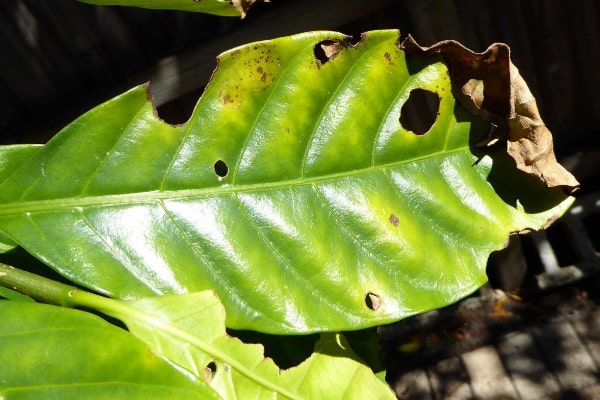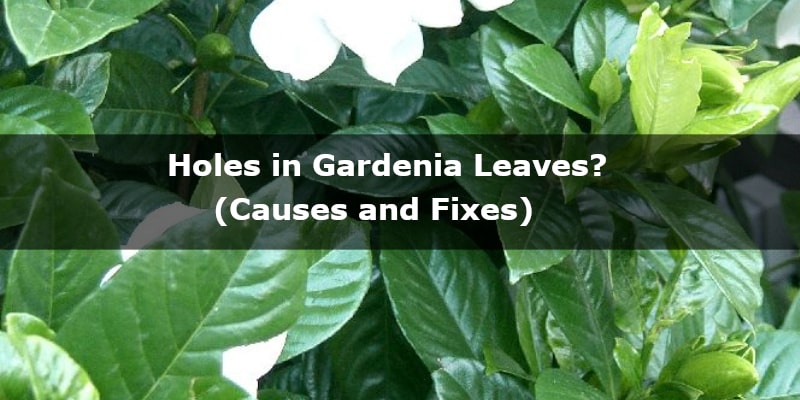So, there are holes in your gardenia leaves?
Don’t worry. I’m an experienced gardener, and I know what’s the cause of the problem, and how to treat it.
What Can Cause Gardenia Leaves Holes?
There are 4 main reasons that can cause holes in gardenia leaves. The most popular ones are fungal disease, and caterpillars. The right treatment and prevention should save your plant.
If the holes in the leaves of your gardenia are yellowing, or browning, you can be sure it’s because of fungal disease. However, if the holes are rough, but without color change, it might be caterpillars presence.
However, beetles, weevils, or snails might also cause the holes in the leaves.
Read on to identify the cause, and learn how you can fix it!
Fungal Disease
One of the most common reasons behind holes in gardenia leaves is fungus presence. There are many fungi that attack gardenia plants. The most popular ones inlcude anthracnose, cercospora, shot hole disease, and stem canker.
If your gardenia is kept in rather humid conditions, with poor air circulation, overcrowded, and watered from above, you can be sure that the fungi causes holes in the leaves.

Initially, fungi diseases present themselves on the leaves in the form of yellow, discolored or wet-looking spots. In many cases, undersides of spots may show fuzzy fungal growth.
Then spots turn brown and dead centers fall out. At the end, brown or yellow halos remain around the holes. Also, depending on the variety of fungus, stems, and flowers might be also affected.
The best thing you can do is prevention, and treatment. You should give your gardenia plenty of room, and avoid overhead watering. Also, water early in the day to let the leaves dry before nightfall. If some leaves are highly affected, cut them back.
Without treating the fungi, it might eventually kill your gardenia, so you should act as soon as possible.
When it comes to treatment, you should apply a good fungicide like this one on Amazon. It will kill and prevent fungus. In addition, in order to rebuild strength of your gardenia, you can apply a 10-10-10 fertilizer (buy it here on Amazon).
CaterpillarsÂ
Caterpillars show up in the yard, usually around late summer and early fall. They are simply larvae that are transforming into moths and butterflies.
Caterpillars chew leaves, stems, or roots of gardenia, leaving holes in them. Usually, larvae that like eating your gardenia are hornworms, cutworms, or armyworms. Some caterpillars are tiny, some can be as big as 4 inches (10 cm).
You can recognize caterpillar presence by examining your gardenia. The holes on the leaves vary in size, their edges are rough, and the holes appear in the center, and on the edges of the leaves. Sometimes, you might notice dark fecal droppings.
How to fight with caterpillars? You can pluck the caterpillars off your plants and drop them into a bucket of soapy water. You can read more about it in this article.
To get rid of the eggs of caterpillars, you can purchase neem oil.
You can also buy natural predators like ladybugs. In many cases, caterpillars can be eaten by natural predators like parasitic flies, wasps or spiders. Avoid insecticides that might kill beneficial insects and pollinators
Weevils and Beetles
The black vine weevil and the fuller rose beetle are two pests that can feed on your gardenias.
The larvae of these bugs appear as plump worms. Typically, these larvae feed on the roots of the plant they are infesting, while the adult weevils and beetles munch on the shrub’s leaves.
These chewing insects leave small, and diverse holes with rough or ragged edges.
If you have damaged leaves with chewed foliage, find grubs in the soil to make sure that weevils or beetles are the cause of the problem. The black vine weevil it about 0.5 inches (1.2 cm) long with a black body, while the fuller rose beetle has a brown body with a snout and bulging eyes.
To fix the problem, examine regularly your shrub, and pick off any beetles or weevils that you find. You should dispose them into a bucket of soapy water, or just smash them.
You can also apply a band cover in sticky material around the trunk of the shrub to prevent adult bugs from climbing up the plant to feed on the foliage.
Slugs and Snails
If you didn’t notice any weevils, beetles, or caterpillars, but the foliage of your gardenia is chewed, it can be because of slugs and snails.
The holes in the leaves should be large and irregular, and edges should be smooth. Holes should appear toward leaf centers, not edges.
If you don’t want to invite slugs or snails into your gardenia, the best thing to do is applying slug and snail killer that kill these animals through a dehydration process.
FAQ
Do Holes in Gardenia Leaves Affect its Health?
Holes in gardenia leaves won’t affect the health and growth of the plant. The holes will only ruin the appearance of your gardenia.
Will Holes in Gardenia Leaves Be There Forever?
Holes in the gardenia leaves won’t recover, and they will be present as long as the plant is alive.
Should You Remove Gardenia Leaves With Holes?
If the leaves of gardenia look relatively good, and they don’t contain a lot of holes, you shouldn’t cut them back. You should remove highly affected leaves that look bad.

